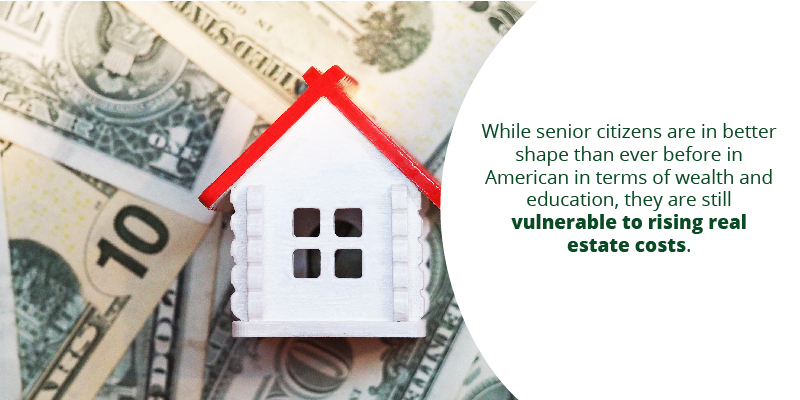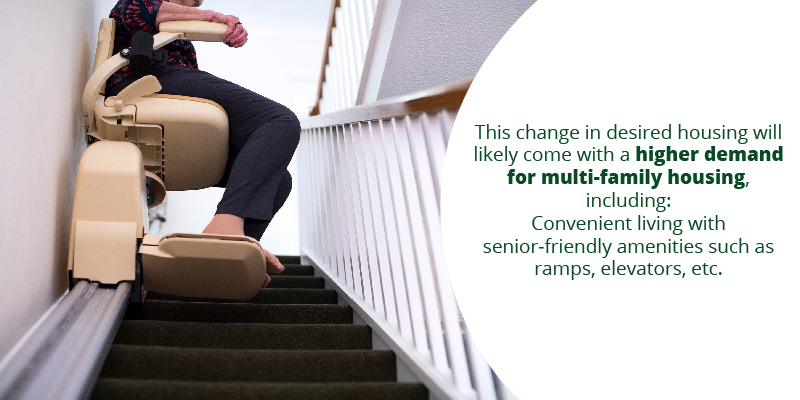
It is no great secret that our country is aging. In fact, recent estimates provided by the US Census Bureau project that “older people (are) projected to outnumber children for the first time in US history” within the next 10 years. Not only will this put an economic strain on our nation, but it will also challenge our existing resources and infrastructure. An example of this strain is the existing problem of demand for senior housing outpacing our current supply. This dynamic is likely to impact the landscape of commercial real estate for years to come, but how?
Today, we will review the current reality of seniors’ housing needs, what those needs are likely to look like in the near future, and how these shifting realities will impact the CRE industry today and moving forward.
Senior Citizen Demographics by the Numbers in 2020 and Beyond

To understand senior housing, we must first understand the senior citizen demographic in the US. Here are some fast facts on senior citizens in America:
- Over 50 million Americans are aged 65 or older. It should be noted that this estimate is on the conservative side based on available Census data.
- The population of senior citizens isn’t just projected to rise, it is expected to explode. Where 2018 statistics put the number of Americans aged 65 plus at 52 millions, that number will be approximately 95 million by the year 2060.
- Older Americans are also getting more diverse over time. Today, approximately 77 percent of Americans 65 plus are white. That number is expected to fall to 55 percent by 2060. Despite this increase in diversity, older generations will continue to lag behind younger generations in terms of ethnic diversity.
Additional facts about senior citizens that remain relevant to our conversation about housing and CRE include: aging generations having higher levels of education, longer life expectancies, and significantly lower poverty rates.
Low Affordable Housing Supply May Price Seniors Out of Their Communities

While senior citizens are in better shape than ever before in American in terms of wealth and education, they are still vulnerable to rising real estate costs. For extremely low-income renter households, only 35 rental homes are available for every 100 families in need. This is an example of a problem for senior citizens: they are particularly susceptible to being priced out of their own neighborhoods. Coupled with a national housing shortage and a rapidly aging population, rising real estate costs are a very real problem for seniors.
In Pittsburgh, we can see this in neighborhoods like Lawrenceville. From the years 2010 to 2017, the median home sales price jumped from $95k to $237k. That is nearly a 150% increase in less than a decade. Many working class families who have been living in Lawrenceville for decades have been forced to look elsewhere for affordable housing options. Again, senior citizens find themselves being hit the hardest.
How America’s Aging Population will Impact Commercial Real Estate
The Baby Boomer generation is in prime retirement age in the US. With that paradigm shift, the commercial real estate market is looking to adjust. Baby Boomers have been driving the residential real estate market for 20 plus years. Now they are about to drive the rental and commercial real estate markets in a new way.
Baby Boomer retirement likely to increase demand for multifamily housing
Retiring adults have been showing more inclination towards “downsizing” as they approach retirement age. This means that the Baby Boomer generation is going to be predominantly looking for affordable housing and/or rental opportunities for the first time in many years. This change in desired housing will likely come with a higher demand for multi-family housing, including:
- Apartment complexes aimed toward senior citizen needs
- Gated townhome communities
- Any residential plans which take care of lawn care, home maintenance, etc.
- Convenient living with senior-friendly amenities such as ramps, elevators, etc.

Another key factor to remember is that many senior citizens desire to stay local as they downsize. This means that these amenities are going to be desired in their current suburban/urban neighborhoods for affordable rates. This creates a potentially lucrative opportunity for commercial real estate developers and/or investors to get ahead of a rapidly aging US population.
Going Forward
All signs point to senior citizens moving away from their single family homes into smaller single family homes, multi-family homes, or other senior-friendly accomodations. This is nothing new. What is new is that the population of Americans aged 65 plus is expected to nearly double over the next 40 years. As life expectancy continues to climb, older generations will be looking for affordable and convenient housing options in record numbers. From the perspective of the commercial real estate professional, the question becomes how our industry will adapt to this change.
Western Pennsylvania has already had an upturn in new construction for senior citizen centers, medical facilities, and other infrastructure to accommodate an aging population. Yet housing shortages and other factors will continue to create a situation where senior citizen demand for affordable and convenient housing will likely outpace the supply.
